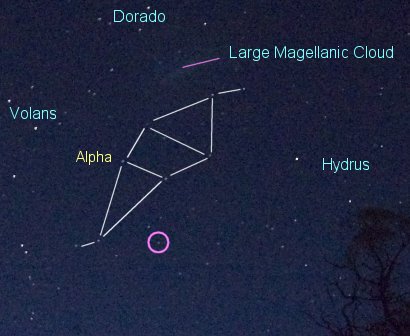

THE PLANETThe circle shows the location of the class G1 dwarf Pi Mensae (in the constellation Mensa). The planet has one of the highest masses known, at least 10.35 times that of Jupiter, which is close to the limit at which we might call it a brown dwarf (13 Jupiter masses, at which point its internal temperature is high enough for it to fuse its natural deuterium into helium). That is, it may not be a planet at all. Whatever it is, the companion to Pi Mensae averages 3.29 Astronomical Units from the star (494 million kilometers, 307 million miles, 63 percent the size of Jupiter's orbit) and orbits with a period of 5.65 years. The orbit is fairly elliptical, the planet coming as close as 2.1 AU from the star and going as far as 5.3 AU. Photo by Greg Dimijian. |